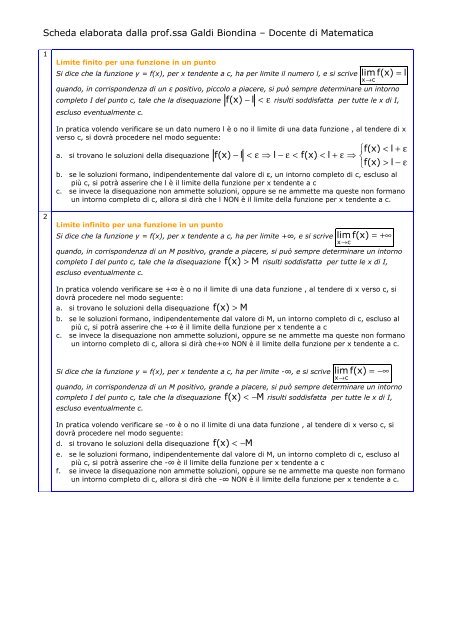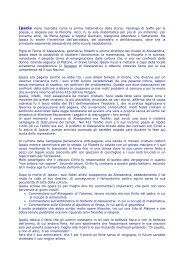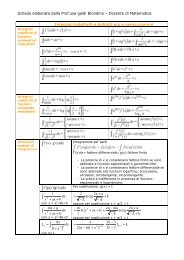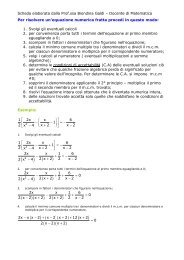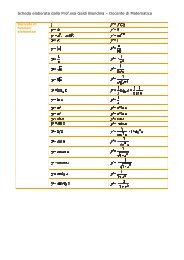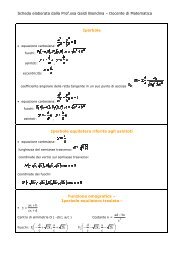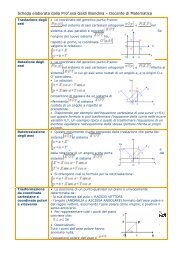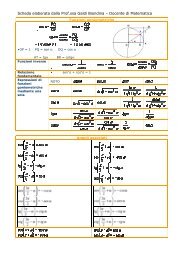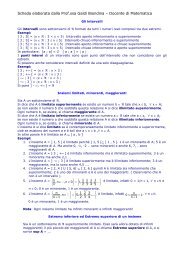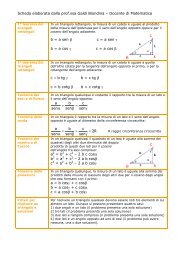Definizioni di limite - Operazioni sui limiti - Galdi Biondina
Definizioni di limite - Operazioni sui limiti - Galdi Biondina
Definizioni di limite - Operazioni sui limiti - Galdi Biondina
You also want an ePaper? Increase the reach of your titles
YUMPU automatically turns print PDFs into web optimized ePapers that Google loves.
Scheda elaborata dalla prof.ssa Gal<strong>di</strong> Bion<strong>di</strong>na – Docente <strong>di</strong> Matematica<br />
1<br />
2<br />
Limite finito per una funzione in un punto<br />
Si <strong>di</strong>ce che la funzione y = f(x), per x tendente a c, ha per <strong>limite</strong> il numero l, e si scrive<br />
x→c lim f(x) = l<br />
quando, in corrispondenza <strong>di</strong> un ε positivo, piccolo a piacere, si può sempre determinare un intorno<br />
completo I del punto c, tale che la <strong>di</strong>sequazione f(x) − l < ε risulti sod<strong>di</strong>sfatta per tutte le x <strong>di</strong> I,<br />
escluso eventualmente c.<br />
In pratica volendo verificare se un dato numero l è o no il <strong>limite</strong> <strong>di</strong> una data funzione , al tendere <strong>di</strong> x<br />
verso c, si dovrà procedere nel modo seguente:<br />
⎧f(x)<br />
< l + ε<br />
f(x) − l < ε ⇒ l − ε < f(x) < l + ε ⇒ ⎨<br />
a. si trovano le soluzioni della <strong>di</strong>sequazione<br />
⎩f(x)<br />
> l − ε<br />
b. se le soluzioni formano, in<strong>di</strong>pendentemente dal valore <strong>di</strong> ε, un intorno completo <strong>di</strong> c, escluso al<br />
più c, si potrà asserire che l è il <strong>limite</strong> della funzione per x tendente a c<br />
c. se invece la <strong>di</strong>sequazione non ammette soluzioni, oppure se ne ammette ma queste non formano<br />
un intorno completo <strong>di</strong> c, allora si <strong>di</strong>rà che l NON è il <strong>limite</strong> della funzione per x tendente a c.<br />
Limite infinito per una funzione in un punto<br />
Si <strong>di</strong>ce che la funzione y = f(x), per x tendente a c, ha per <strong>limite</strong> +∞, e si scrive<br />
x→c lim f(x) = +∞<br />
quando, in corrispondenza <strong>di</strong> un M positivo, grande a piacere, si può sempre determinare un intorno<br />
completo I del punto c, tale che la <strong>di</strong>sequazione f(x) > M risulti sod<strong>di</strong>sfatta per tutte le x <strong>di</strong> I,<br />
escluso eventualmente c.<br />
In pratica volendo verificare se +∞ è o no il <strong>limite</strong> <strong>di</strong> una data funzione , al tendere <strong>di</strong> x verso c, si<br />
dovrà procedere nel modo seguente:<br />
a. si trovano le soluzioni della <strong>di</strong>sequazione f(x) > M<br />
b. se le soluzioni formano, in<strong>di</strong>pendentemente dal valore <strong>di</strong> M, un intorno completo <strong>di</strong> c, escluso al<br />
più c, si potrà asserire che +∞ è il <strong>limite</strong> della funzione per x tendente a c<br />
c. se invece la <strong>di</strong>sequazione non ammette soluzioni, oppure se ne ammette ma queste non formano<br />
un intorno completo <strong>di</strong> c, allora si <strong>di</strong>rà che+∞ NON è il <strong>limite</strong> della funzione per x tendente a c.<br />
Si <strong>di</strong>ce che la funzione y = f(x), per x tendente a c, ha per <strong>limite</strong> -∞, e si scrive lim f(x) = −∞<br />
x→c quando, in corrispondenza <strong>di</strong> un M positivo, grande a piacere, si può sempre determinare un intorno<br />
completo I del punto c, tale che la <strong>di</strong>sequazione f(x) < − M risulti sod<strong>di</strong>sfatta per tutte le x <strong>di</strong> I,<br />
escluso eventualmente c.<br />
In pratica volendo verificare se -∞ è o no il <strong>limite</strong> <strong>di</strong> una data funzione , al tendere <strong>di</strong> x verso c, si<br />
dovrà procedere nel modo seguente:<br />
d. si trovano le soluzioni della <strong>di</strong>sequazione f(x) < − M<br />
e. se le soluzioni formano, in<strong>di</strong>pendentemente dal valore <strong>di</strong> M, un intorno completo <strong>di</strong> c, escluso al<br />
più c, si potrà asserire che -∞ è il <strong>limite</strong> della funzione per x tendente a c<br />
f. se invece la <strong>di</strong>sequazione non ammette soluzioni, oppure se ne ammette ma queste non formano<br />
un intorno completo <strong>di</strong> c, allora si <strong>di</strong>rà che -∞ NON è il <strong>limite</strong> della funzione per x tendente a c.
Scheda elaborata dalla prof.ssa Gal<strong>di</strong> Bion<strong>di</strong>na – Docente <strong>di</strong> Matematica<br />
3<br />
4<br />
Limite finito per una funzione all’infinito<br />
Si <strong>di</strong>ce che la funzione y = f(x), per x tendente a +∞, ha per <strong>limite</strong> il numero l, e si scrive<br />
lim f(x) = l<br />
x→+∞<br />
quando, in corrispondenza <strong>di</strong> un ε positivo, piccolo a piacere, si può determinare un numero N>0, tale<br />
che , per ogni x>N, si abbia f(x) − l < ε<br />
In pratica volendo verificare se un dato numero l è o no il <strong>limite</strong> <strong>di</strong> una data funzione , al tendere <strong>di</strong> x<br />
verso +∞, si dovrà procedere nel modo seguente:<br />
⎧f(x)<br />
< l + ε<br />
f(x) − l < ε ⇒ l − ε < f(x) < l + ε ⇒ ⎨<br />
a. si trovano le soluzioni della <strong>di</strong>sequazione<br />
⎩f(x)<br />
> l − ε<br />
b. se le soluzioni della <strong>di</strong>sequazione sono maggiori <strong>di</strong> un numero N positivo, allora si potrà asserire<br />
che è l il <strong>limite</strong> della funzione per x tendente a +∞<br />
c. se invece la <strong>di</strong>sequazione non ammette soluzioni, oppure se ne ammette ma queste non sono<br />
maggiori <strong>di</strong> un numero positivo N, allora si <strong>di</strong>rà che l NON è il <strong>limite</strong> della funzione per x tendente<br />
a +∞.<br />
Si <strong>di</strong>ce che la funzione y = f(x), per x tendente a -∞, ha per <strong>limite</strong> il numero l, e si scrive<br />
lim f(x) = l<br />
x→−∞<br />
quando, in corrispondenza <strong>di</strong> un ε positivo, piccolo a piacere, si può determinare un numero N>0, tale<br />
che , per ogni x − ε<br />
a. si trovano le soluzioni della <strong>di</strong>sequazione<br />
⎩f(x)<br />
l<br />
b. se le soluzioni della <strong>di</strong>sequazione sono minori <strong>di</strong> un numero -N negativo, allora si potrà asserire<br />
che è l il <strong>limite</strong> della funzione per x tendente a -∞<br />
c. se invece la <strong>di</strong>sequazione non ammette soluzioni, oppure se ne ammette ma queste non sono<br />
minori <strong>di</strong> un numero -N, allora si <strong>di</strong>rà che l NON è il <strong>limite</strong> della funzione per x tendente a -∞.<br />
Limite infinito per una funzione all’infinito<br />
Si <strong>di</strong>ce che la funzione y = f(x), per x tendente a +∞, ha per <strong>limite</strong> +∞ (oppure -∞), e si scrive<br />
lim f(x) = +∞ oppure lim f(x) = −∞<br />
x<br />
x→+∞<br />
→+∞<br />
quando, in corrispondenza <strong>di</strong> un M positivo, grande a piacere, si può sempre determinare un numero<br />
N>0, tale che, per ogni x>N, risulta f(x)>M (oppure, f(x)M ( oppure f(x) 0, tale che, per ogni xM (oppure, f(x)
Scheda elaborata dalla prof.ssa Gal<strong>di</strong> Bion<strong>di</strong>na – Docente <strong>di</strong> Matematica<br />
a. si trovano le soluzioni della <strong>di</strong>sequazione f(x)>M ( oppure f(x) 0<br />
⎨<br />
⎩K<br />
< 0<br />
= +∞ e lim g(x) = m<br />
x→c allora<br />
⎧lim<br />
Kf(x) = +∞<br />
⎪x→c<br />
⎨<br />
⎪⎩<br />
lim Kf(x) = −∞<br />
x→c ⎧lim ⎡f(x) ⋅ g(x) ⎤ = +∞<br />
⎧m<br />
> 0<br />
⎪ ⎣ ⎦<br />
x→c con ⎨<br />
allora ⎨<br />
⎩m<br />
< 0<br />
⎪lim ⎡f(x) ⋅ g(x) ⎤ = −∞<br />
⎩ ⎣ ⎦<br />
x→c ⎧+∞<br />
⎧+∞<br />
⎧+∞<br />
⎪<br />
= ⎨−∞<br />
e<br />
⎪<br />
lim g(x) = ⎨−∞<br />
allora<br />
⎪<br />
lim ⎡⎣ f(x) ⋅ g(x) ⎤⎦ = ⎨+∞<br />
x→c x→c ⎪<br />
⎩+∞<br />
⎪<br />
⎩−∞<br />
⎪<br />
⎩−∞<br />
1<br />
= ±∞ allora lim = 0<br />
x→c f(x)<br />
= e<br />
x→c f(x)<br />
lim g(x) = ±∞ allora lim =<br />
0<br />
x→c g(x)
Scheda elaborata dalla prof.ssa Gal<strong>di</strong> Bion<strong>di</strong>na – Docente <strong>di</strong> Matematica<br />
Se lim f(x)<br />
x→c f(x)<br />
= ±∞ e lim g(x) = l ( ≥ 0) allora lim = ±∞<br />
x→c x→c g(x)<br />
Forme indeterminate o <strong>di</strong> indecisione<br />
1 Nulla si può <strong>di</strong>re, in generale,<br />
sul lim ⎡⎣ f(x) ± g(x) ⎤⎦<br />
x→c quando è lim f(x)<br />
x→c 2 sul lim ⎡⎣ f(x) ⋅ g(x) ⎤⎦<br />
x→c quando è lim f(x) = 0 e<br />
x→c x→c 3<br />
4<br />
sul<br />
x→c sul<br />
x→c f(x)<br />
lim<br />
g(x)<br />
f(x)<br />
lim<br />
g(x)<br />
= +∞ e lim g(x) = −∞<br />
x→c lim g(x) = ∞<br />
quando è lim f(x) = 0 e lim g(x) = 0<br />
x→c x→c quando è lim f(x)<br />
x→c = ∞ e lim g(x) = ∞<br />
x→c


